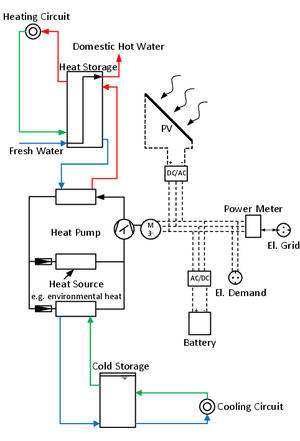PVCool: Integrated Solar PV Power and Air Cooling System for Future Houses in Modern Agro-Industrial Communities in Qatar
Supervisor | Subject |
|---|---|
Editor | Cooperation/Funding |
| Prof. Dr.-Ing. Thomas Sattelmayer |
|
| Bernd Heithorst, M.Sc. | Qatar Environment and Energy Research Institute (QEERI)
|
Motivation
Thermal conditioning of residential buildings plays a major role in the energy consumption of countries in a temperate climate as well as in the hot and humid climate of countries in the Golf region. The market share of HVAC-devices powered by renewable energy is low for both regions. This issue is addressed in the PVCool project of the Institute of Thermodynamics at TUM and the Qatar Environment and Energy Research Institute (QEERI).
Compression chillers (CC) directly coupled with photovoltaic (PV) systems (PV-CC) have gained increased attention, mainly due to the decreasing costs of PV systems and the low investment costs of conventional compression chillers, which makes them more and more economically feasible. However, one of the main challenges in PV-CC is their unsteady operation and low part-load capability under solar irradiation conditions. A novel low part-load CC system promises improvements in process dynamics [1] and an increase in PV self-consumption, since a wider range of the transient PV power is usable [2].
Therefore, a swash-plate compressor, that is typically used in mobile applications, is integrated into a CC for residential buildings. On the solar energy supply side, the operation of PV systems under the high ambient temperatures, the high dust loads, and the high air humidity in Qatar represents one of the major challenges for all PV applications. As the efficiency of PV cells drops significantly at high temperatures when the cooling demand is also high, active thermal management of PV cells becomes a necessity. While the cooling of PV modules is needed only during day time, the condensation of air humidity on PV panels should be avoided during both day and night. This prevents the formation of mud, caused by dusty air and the condensed water on the PV surface. The project aims to address the technical challenges mentioned above, while developing and optimizing a solar PV system to supply electrical power and air conditioning for domestic applications.
Experimental and Numerical Studies
To achive the project aims, numerical and experimental investigations are carried out. At the Institute of Thermodynamics at TUM, a heat pump and compression chiller test-rig is developed and implemented. In this test-rig, the swash-plate compressor is compared with a scroll compressor, which is commonly applied in domestic HVAC facilities and therefore the benchmark for this investigation. Tasks of the experimental comparison are testing and optimization of the test-rig, comparison of efficiency and controllability of the compressors, developement and implementation of compressor control strategies and, finally, the design of a pilot plant.
A PV test field is designed and constructed by the project partner QEERI in Doha, Qatar, with the focus on active thermal management of the PV system.
For the numerical simulation of the complete energy system, depicted in Figure 1, a building model is implemented together with a transient simulation of the CC in the simulation environment DYMOLA and the other HVAC components like thermal and electrical storages. The aim of the numerical investigation is the optimized dimensioning of the process components for both residential buildings and greenhouses. Furthermore, it is necessary to identify a optimal refrigerant fluid for the Qatari climate.
References
[1] Spinnler, M., Hörth, L., Böing, F., Wolf, S., Sattelmayer, T., ”Novel Heat Pump System for Highly Transient PV Operation”; Proceedings of the Europeen PV Solar Energy Conference and Exhibition, Amsterdam, 2014
[2] Heithorst, B., Kiefer, F., Shen, J., Kastl, A., Präbst, A., Spinnler, M., Sattelmayer, T., ”Optimized Demand Side Management and Minimized Battery Storage for High Self-Consumption With PV-Driven Low-Part-Load Heat Pumps”; Proceedings of the Europeen PV Solar Energy Conference and Exhibition, Munich, 2016
Acknowledgements

The presented work is funded by the Qatar National Research Fund which is gratefully acknowledged.
